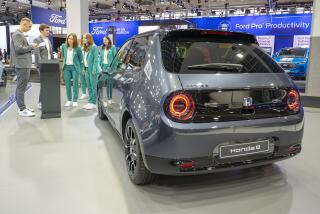Honda Tells Plan to Export U.S.-Built Autos to Japan
- Share via
Nearly five years after it became the first Japanese auto maker to produce cars in the United States, Honda is now on the verge of becoming the first to reverse the tide and export American-built cars to Japan.
Honda, which last year surpassed Toyota to become the top-selling Japanese car company in the United States, plans to export cars from its giant Marysville, Ohio, assembly complex back to Japan within the next two to three years if the exchange rate between the Japanese yen and the U.S. dollar stabilizes in its current trading range, Honda executives said in interviews this week.
Indeed, Honda’s plan to export cars from the United States back to Japan seems to be one of the most dramatic examples to date of how the enormous increase in the value of the yen versus the dollar is starting to affect trade between the two nations. The yen has risen more than 60% in value against the dollar since September, 1985, making Japanese products more expensive in world markets.
As a result, the cost advantage the Japanese have long enjoyed over American auto makers has been all but eliminated, said Tetsuo Chino, president of American Honda Motor Co., Honda’s North American sales arm in Gardena.
Now, Chino says, Honda can produce cars just as cheaply in Ohio as in Japan. In fact, if Honda’s Marysville plant can reduce its dependence on Japanese-built auto parts that have become more expensive because of the rapid rise in the value of the yen, Hondas built in Ohio will be even cheaper than those produced in Japan, he added.
As a result, Honda executives--convinced that the quality of their American-built cars is up to Japanese standards--are close to approving a plan under which a new generation of large, upscale passenger cars would be built exclusively in the United States, for sale in America, Japan and other overseas markets.
The Hondas built in Ohio for export would be equipped with right-side steering to accommodate the Japanese, who drive on the left side of the road, a company spokesman noted.
“Currently it is still in the study stage, but if the exchange rate stays at 145 or 150 (yen to the dollar), it is likely” Honda will go through with such an export plan, said Shinichi Tanaka, a Honda spokesman in Detroit.
Chino said that since the United States would be the primary market for such a large model, it would be more economical to build it here, while forgoing any production of the car line in Japan, where Honda is suffering from a shortage of production capacity.
Competitiveness Increasing
“Now, Marysville’s competitiveness versus our Japanese plants is increasing, because of the appreciation of the yen, and because production levels there have risen to the point where we now have a more efficient, more productive operation,” said Chino. “So the cost of an Accord coming off the end of the assembly line is now the same in Marysville as it is in Sayama (Honda’s Japanese Accord plant.)
“That is why I’m considering exporting cars from Marysville to Japan.”
The company expects to choose from among two or three new car lines now under development for its U.S. export project, Chino added.
Chino refused to say how many units it might export each year to Japan or identify which cars were under study. Still, Honda seems to be focusing on its high-priced Acura Legend luxury car. A large model primarily designed for the American market, the next generation might be built only in the United States and not in Japan.
“If we have a new car that has a market primarily in the U.S., then we might only build it here and export it back to Japan,” said Chino.
Still, Japan won’t be the first export market for Honda’s U.S.-built products. The company already exports American-made motorcycles and lawn mowers around the world, and now is shipping 2,000 Ohio-built Accords annually to Taiwan, which prohibits car imports from Japan. Meanwhile, Honda’s Japanese operations also now import American-built parts from 23 U.S. suppliers for installation on cars assembled in Japan, according to Honda spokesman Kurt T. Antonius.
Represents Unusual Twist
Although Honda executives cautioned that the Japanese export project could be canceled if the U.S. dollar stages a recovery against the yen, the plan still seems to represent the most unusual twist yet in America’s long struggle to compete with Japan at a time when trade friction between the two nations is reaching new heights.
But what is perhaps most remarkable is that it has taken a Japanese company to prove that U.S.-made products can still be cost-competitive in a basic industry that has all too often seemed destined to move offshore. And, by exporting cars from the United States back to Japan, Honda may be able to disprove the charges leveled by American auto makers that Japanese trade barriers make it impossible for U.S.-built cars to make inroads into the Japanese market.
Indeed, Honda is apparently not the only Japanese company studying the possibility of exporting cars from America. Mazda, which plans to begin producing a new version of its 626 mid-size sedan in a Michigan assembly plant next fall, is also reportedly considering a plan to export 626s back to Japan. “It is one of many options under study,” a Mazda spokesman acknowledged Wednesday.






